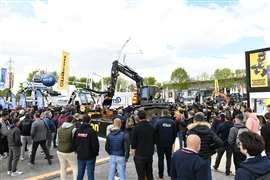Subsidies, IC engine transition among power-related challenges heard at Intermat
07 May 2024
With Intermat 2024 now relegated to history, Power Progress editors and their colleagues who attended the show have had time to reflect on the power-related trends that have come out of it.
Murray Pollok, director of content for KHL Group, which publishes Power Progress, reported that Intermat successfully focused on sustainability and decarbonization. This was evidenced in part by the variety of products on display powered by batteries or other alternative energy sources. However, the show affirmed a couple of headwinds needing to be overcome on the road to net zero.
Struggles with Subsidies
 There were more than 127,000 visitors to Intermat 2024. (Photo: Intermat)
There were more than 127,000 visitors to Intermat 2024. (Photo: Intermat)
Getting equipment customers to invest in new power technologies is challenging because it is typically more expensive. Battery electric (BE) equipment, for example, can cost twice as much as other technologies — about twice the cost of those used in automotive applications — despite the investment being made in electric machinery. This is in part due to the additional protections and design work required as well as lower volumes.
Government subsidies are one approach to helping fund the sustainable energy transition. However, much discussion at Intermat focused on lack of financial incentives in this regard.
“We have to make choices, but it’s clear there has to be some incentives”, said Fabrice Blanc, equipment director at contractor Eiffage, speaking at one of the exhibition’s industry forums, “Why are there no subsidies? At some time, they will have to help us. We are doing what we can, but to do so for all worksites, with no incentives, we can’t do.”
Rental companies are bearing the brunt of the energy transition, as their customers are asking for low-carbon equipment. Olivier Grisez, managing director of the French arm of rental company Loxam, echoed Blanc’s sentiment in the same forum.
“If there is no clear incentive, we will be blocked by the cost,” he said. “There has to be something – we need public subsidy. Going electric implies a significant cost.”
Kilotou CEO Olivier Colleau was also clear about the challenges in his remarks during the forum.
“The price of electric machines is up to three times more expensive — batteries are more expensive,” he said. “Today, the sector needs help to carry out this transition.”
IC Transition Headaches
Intermat revealed that the road to net zero emissions is having an impact on the construction equipment industry, as the destination of the journey away from traditional internal combustion (IC) power solutions remains unclear.
One manufacturer of compact and light equipment told Power Progress’ sister publication Construction Briefing that it was investigating four different alternative energy scenarios, all of which involve hydrogen fuel cells and hydrogen combustion. However, the company had not yet arrived at a clear solution — or combination of solutions — best suited to its equipment and customer applications.
Yanmar Construction Equipment (CE) raised concerns about the industry requirement to design and build entirely new BE machine platforms — not just install a battery where once there was an engine. Such a reality means OEMs must produce two distinct platforms until IC engines are phased out, which is particularly expensive.
The company also raised the prospect of some new business models, such as Yanmar CE selling all-electric platforms to other OEMs to use for their own electric machines.
In any case, BE platforms seem to be the way forward, at least in equipment smaller than 10 metric tons. Nonetheless, charging infrastructure and working practices remain issues to be addressed.
Speaking at the aforementioned industry forum, Blanc said that organizing charging facilities on major, long-term sites is less of a problem than on multiple, small and mid-sized locations. He added that creating grid connections for recharging is also a challenge.
Furthermore, some of the equipment launched or previewed at Intermat can only work for half a day on a full charge. That means that even if there is on-site charging, users will have to find a different way of working.
CONTÁCTESE CON EL EQUIPO





